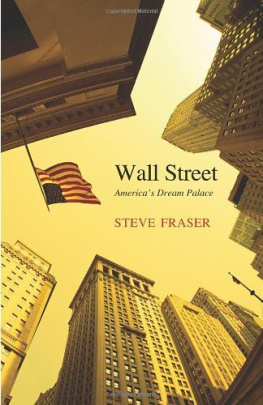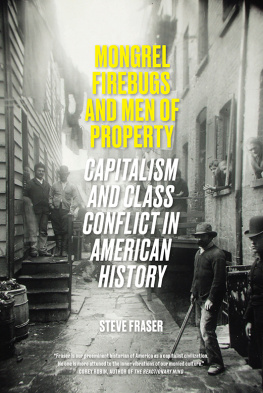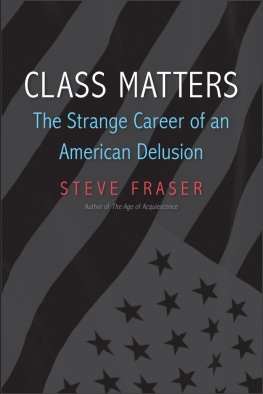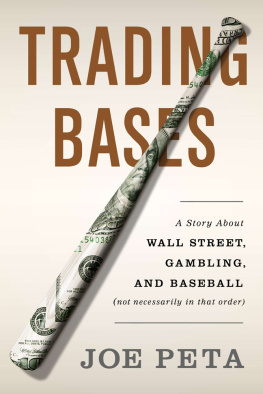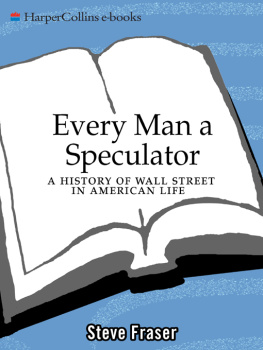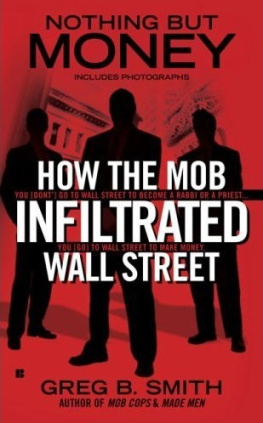Disclaimer: Some images in the printed version of this book are not available for inclusion in the eBook.
Published with assistance from the foundation established in memory of Philip Hamilton McMillan of the Class of 1894, Yale College.
Copyright 2008 by Steve Fraser.
All rights reserved.
This book may not be reproduced, in whole or in part, including illustrations, in any form (beyond that copying permitted by Sections 107 and 108 of the U.S. Copyright Law and except by reviewers for the public press), without written permission from the publishers.
Set in Janson by Integrated Publishing Solutions.
Printed in the United States of America.
Library of Congress Cataloging-in-Publication Data Fraser, Steve, 1945
Wall Street: Americas dream palace / Steve Fraser, p. cm.(Icons of America series)
Includes bibliographical references and index.
ISBN 978-0-300-11755-4 (alk. paper)
. Capitalists and financiersUnited StatesBiography.. Wall Street (New York, N.Y.)History. I. Title.
HG172.A2F72 2008 332.64'273dc22 2007035453
A catalogue record for this book is available from the British Library.
The paper in this book meets the guidelines for permanence and durability of the Committee on Production Guidelines for Book Longevity of the Council on Library Resources.
10 9 8 7 6 5 4 3 2 1
Illustration credits: p. viii: New York Stock Exchange 2007 Jupiterimages Corporation; p. 10: KING Art Parts; p. 54: SHAKDOWN Art Parts; p. 96: WOW_019 Image Club/Getty Images; p. 134: EXEC_DVL Art Parts; p. 174: EASY_MNY Art Parts
Contents
Introduction
one The Aristocrat
two The Confidence Man
three The Hero
four The Immoralist
Epilogue
Notes
Acknowledgments
Introduction
It seems like a dream to me.
DANIEL DREW
Wall Street. No other place on earth is so singularly identified with money and the power of money. Wall Street is not a street; it is the Street. To invoke its name is to conjure up capitalism in all its imperial grandeur. It stands as an unbreachable bulwark defending a commercial order that began when the nation was born. The Street gives off an incandescent glow bred not simply by wealth but by wealth burnished with a patina of prudential sobriety and social preeminence. Deliberation and caution mark its weighty proceedings. Inside its monumental piles of granite, steel, and glass, the equations of economic fitness are calculated with mathematical rigor. Like its very namethe street of streetsit exudes a certain quintessential purity. It hovers above and at some remove from the messiness of the workaday world, distilling its numerical truth, compelling obedience to a higher rationality. Admired or reviled, Wall Street is the towering symbol of a cool, impregnable power.
Yet Wall Street also evokes a radically different set of symbolic associations as the center of mad ambition. Fevers, manias, and frenzies race up and down its pavement like hysterics in a lunatic asylum. Life on the Street cycles between irrational ecstasies and depressive panics. This is the land of financial wilding. Here one indulges all dreams. Here one gambles recklessly on the future. No one is denied entrance to this democracy of the greedy. No one need kowtow to the established order. Irreverence is revered. The world is created anew each day. Wall Street is a carnival, the world turned upside down, where todays confidence man is tomorrows financial seer, a boulevard of endless opportunity and endemic disaster. A hot zone of credulous fools and knowing gamesmen, the Street defies the very orderliness, discipline, and self-abnegating labor of the capitalism it presumably embodies and symbolizes. It rises up in the imagination as an urban demimonde, notorious for its facile swindlers and lupine parasites, where the illicit dream of effortless wealth corrupts and disorders all it touches.
Lodged deep within our collective psyche these contending incongruent images of Wall Street illuminate its paradoxical history in American culture, suggesting that Main Street and Wall Street have found themselves in a strange love-hate codependency for a very long time.
In a culture preoccupied with questions of sin and salvation, Wall Street has served as a protean metaphor. At various times and places, it has stood in for the rich, big business, the money power, parvenu greed, financial piracy, high society on parade, moral and sexual prostitution, Jewish or Anglo-Saxon or capitalist conspiracy, Yankee parasitism, the American Century, the land of Aladdin, and a good deal more. Its truths have been multiple and self-contradictory: deviant and legitimate; heroic and villainous; aristocratic and plebian; rational and insane; anarchic and orderly; liberating and oppressive; muscular and unmanly; libidinal and inhibited; corporate and freebooting; patriotic and treasonous; indispensable and profligate. A vital part of our national iconography, Wall Street has drawn its energy from the antipodes of our moral, social, and intellectual obsessions.
So it is that through the years Wall Street has inspired dreams and nightmares deep inside American culture, leaving its imprint on the lives of ordinary as well some extraordinary people. These private reveries and collective fantasies tell us something fundamental about the Street and its intensely charged role in the national saga. And they do more than that: they tell us something about the mind of Wall Street, but also something about the Wall Streets of the American mind.
Four apparitions especially have captured the popular imagination: the aristocrat, the confidence man, the hero, and the immoralist. These images, while hardly exhausting Wall Streets metaphorical mother lode, have proven the most durable and capacious. As an ensemble they encompass the whole history of the Street, beginning with the American Revolution and running through our own vexed relationship with the Street of dreams at the turn of the new millennium. Wall Street takes a look at these four faces of Wall Street: where they came from, how they have changed along with the country, and why they have proved so enduring.
Wall Street has long nourished its reputation as a hothouse of aristocratic, un-American hauteur. Antipathy toward aristocracy was always a primal element of the national credo. But if ever there was a natural habitat for the nurturing of such an alien species, Wall Street seemed to many to be that place. Aristocratic associations shadowed the Street from the beginning. Condemned first by Thomas Jefferson as counterrevolutionary tories, denizens of the Street were still being ostracized by FDR a century and half later as economic royalists. During the imperial age of J. R Morgan, opposition fixated on Wall Streets frightening omnipotence; after the Great Crash of 1929, however, it was instead the Streets omni-incompetence that made it seem a contemptible as well as a despised and illegitimate aristocratic elite. Indeed, the obloquy that blanketed Wall Street like a funeral shroud consigned it to cultural exile for a long generation, silencing its metaphorical resonance in the public imagination until the age of Reagan.
If the aristocrat seemed a noxious import from the Old World, the confidence man was a native son, born and raised within the American grain. He frequented a different Wall Street, a zone of libidinal desire, a seductive underground peopled by the penniless plutocrat and the dream millionaire. Flourishing first during the Jacksonian era, confidence men shared the dream of instant wealth with their credulous victims. This was Abraham Lincolns land of democratic opportunity minus all the hard work, the parsimony, the slow, laborious rise through the ranks of dependent labor into the liberated air of propertied independence. Here desires and forms of behavior that otherwise violated the norms of respectable middle-class morality were licensed, even celebrated. Wall Street confidence men thrived especially whenever the economy boomed, gulling low and high alike: former President Grant in the 1880s; anonymous masses following after Charles Ponzi during the Roaring Twenties; addictive day-traders afloat on the dot.com bubble of the 1990s. The confidence man manipulated the covetous impulses of his marks, encouraging an irreverent disregard for the maxims of self-renunciatory work and provision for the future. He offered a dream capitalism, weightless, without the gravity of production to hold it down. In those innocent antebellum years unlettered youths from small towns and farms in the American hinterland, relying on their own wits, audacity, and rubbery ethics, could imagine standing toe to toe with baronial financiers and coming out on top. So too more than century later, during the age of what one writer called the dot.con, men from nowhere, without social pedigrees or Ivy League educations, would dream of unhorsing Wall Streets white shoe aristocrats, along the way gulling a whole nation to buy into their improbable fantasies.

